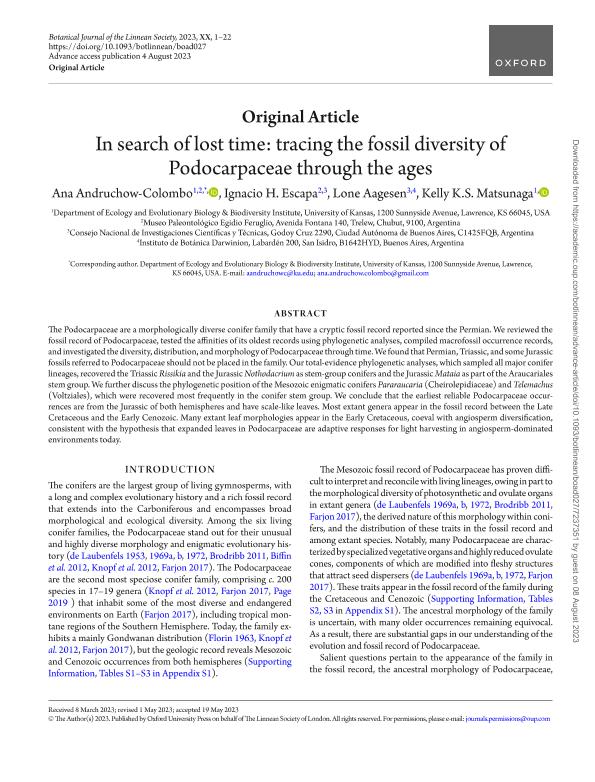Artículo
In search of lost time: tracing the fossil diversity of Podocarpaceae through the ages
Fecha de publicación:
08/2023
Editorial:
Wiley Blackwell Publishing, Inc
Revista:
Botanical Journal of The Linnean Society
ISSN:
0024-4074
Idioma:
Inglés
Tipo de recurso:
Artículo publicado
Clasificación temática:
Resumen
The Podocarpaceae are a morphologically diverse conifer family that have a cryptic fossil record reported since the Permian. We reviewed the fossil record of Podocarpaceae, tested the affinities of its oldest records using phylogenetic analyses, compiled macrofossil occurrence records, and investigated the diversity, distribution, and morphology of Podocarpaceae through time. We found that Permian, Triassic, and some Jurassic fossils referred to Podocarpaceae should not be placed in the family. Our total-evidence phylogenetic analyses, which sampled all major conifer lineages, recovered the Triassic Rissikia and the Jurassic Nothodacrium as stem-group conifers and the Jurassic Mataia as part of the Araucariales stem group. We further discuss the phylogenetic position of the Mesozoic enigmatic conifers Pararaucaria (Cheirolepidiaceae) and Telemachus (Voltziales), which were recovered most frequently in the conifer stem group. We conclude that the earliest reliable Podocarpaceae occurrences are from the Jurassic of both hemispheres and have scale-like leaves. Most extant genera appear in the fossil record between the Late Cretaceous and the Early Cenozoic. Many extant leaf morphologies appear in the Early Cretaceous, coeval with angiosperm diversification, consistent with the hypothesis that expanded leaves in Podocarpaceae are adaptive responses for light harvesting in angiosperm-dominated environments today.
Palabras clave:
PODOCARPACEAE
,
FILOGENIA
,
MORFOLOGIA
,
FOSSILES
Archivos asociados
Licencia
Identificadores
Colecciones
Articulos(IBODA)
Articulos de INST.DE BOTANICA DARWINION (I)
Articulos de INST.DE BOTANICA DARWINION (I)
Citación
Andruchow Colombo, Ana; Escapa, Ignacio Hernán; Aagesen, Lone; Matsunaga, Kelly K. S.; In search of lost time: tracing the fossil diversity of Podocarpaceae through the ages; Wiley Blackwell Publishing, Inc; Botanical Journal of The Linnean Society; 203; 4; 8-2023; 315-336
Compartir
Altmétricas




